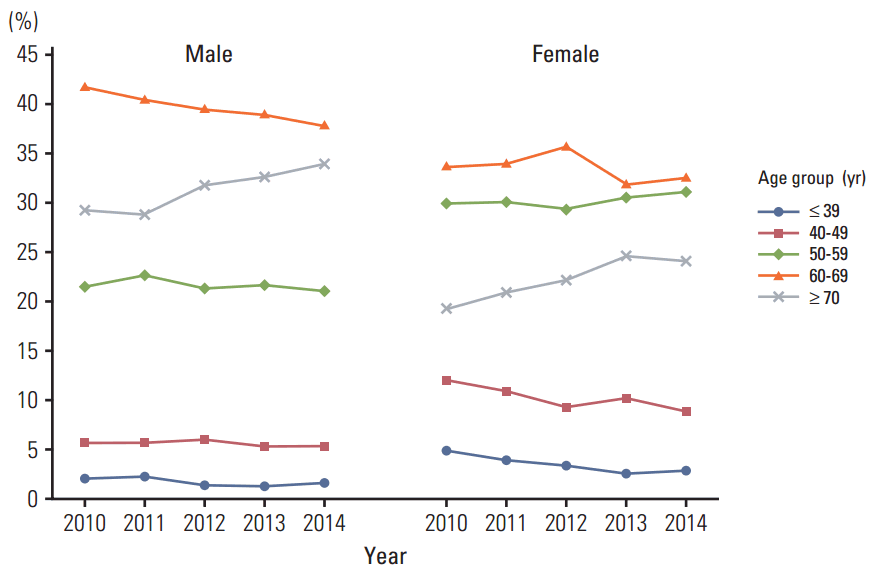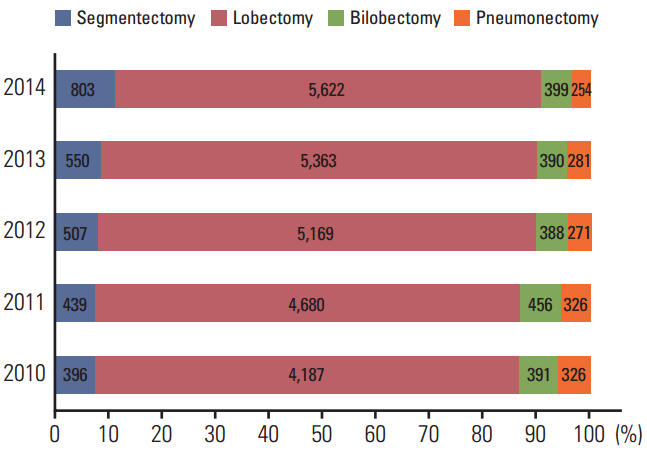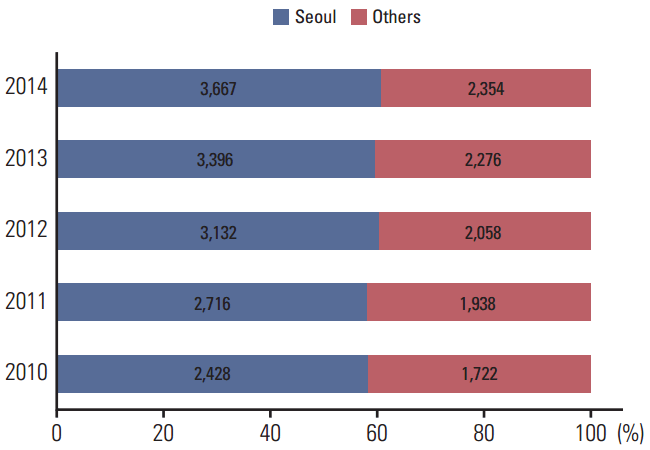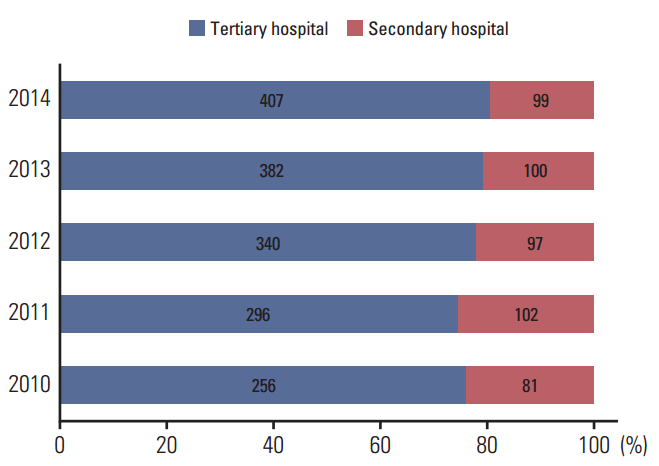1. Jung KW, Won YJ, Kong HJ, Oh CM, Cho H, Lee DH, et al. Cancer statistics in Korea: incidence, mortality, survival, and prevalence in 2012. Cancer Res Treat. 2015; 47:127–41.

2. Ferlay J, Soerjomataram I, Dikshit R, Eser S, Mathers C, Rebelo M, et al. Cancer incidence and mortality worldwide: sources, methods and major patterns in GLOBOCAN 2012. Int J Cancer. 2015; 136:E359–86.

3. OECD.stat [Internet]. Paris: Organisation for Economic Co-operation and Development;2015. [cited 2015 Dec 9]. Available from:
http://stats.oecd.org/.
4. The Korea Central Cancer Registry; National Cancer Center. Annual report of cancer statistics in Korea in 2012 [Internet]. Goyang: National Cancer Information Center;2014. [cited 2015 Oct 15]. Available from:
http://www.cancer.go.kr.
5. Jung KW, Won YJ, Oh CM, Kong HJ, Cho H, Lee DH, et al. Prediction of cancer incidence and mortality in Korea, 2015. Cancer Res Treat. 2015; 47:142–8.

6. Dillman RO, McClure SE. Steadily improving survival in lung cancer. Clin Lung Cancer. 2014; 15:331–7.

7. Siegel RL, Miller KD, Jemal A. Cancer statistics, 2015. CA Cancer J Clin. 2015; 65:5–29.

8. The Korea Central Cancer Registry, National Cancer Center. Annual report of cancer statistics in Korea in 2011 [Internet]. Goyang: National Cancer Information Center; 2013 [cited 2015 Oct 15]. Available from: http://www.cancer.go.kr.
9. The Korea Central Cancer Registry, National Cancer Center. Annual report of cancer statistics in Korea in 2010 [Internet]. Goyang: National Cancer Information Center; 2012 [cited 2015 Oct 15]. Available from: http://www.cancer.go.kr.
10. National Lung Screening Trial Research Team, Aberle DR, Adams AM, Berg CD, Black WC, Clapp JD, et al. Reduced lung-cancer mortality with low-dose computed tomographic screening. N Engl J Med. 2011; 365:395–409.

11. Korea Centers for Disease Control and Prevention. Korea Health Statistic 2013: Korea National Health and Nutrition Examination Survery (KNHANES VI-1) [Internet]. Cheongju: Centers for Disease Control and Prevention;2013. [cited 2015 Oct 15]. Available from:
http://knhanes.cdc.go.kr.
12. Population Division, Department of Economic and Social Affairs, United Nations. World population ageing 2013 [Internet]. New York: United Nations;2013. [cited 2015 Dec 2]. Available from:
http://www.un.org/.
13. Kwon S. Thirty years of national health insurance in South Korea: lessons for achieving universal health care coverage. Health Policy Plan. 2009; 24:63–71.

14. Morgant MC, Pages PB, Orsini B, Falcoz PE, Thomas PA, Barthes FL, et al. Time trends in surgery for lung cancer in France from 2005 to 2012: a nationwide study. Eur Respir J. 2015; 46:1131–9.

15. Strand TE, Bartnes K, Rostad H. National trends in lung cancer surgery. Eur J Cardiothorac Surg. 2012; 42:355–8.

16. Riaz SP, Linklater KM, Page R, Peake MD, Moller H, Luchtenborg M. Recent trends in resection rates among non-small cell lung cancer patients in England. Thorax. 2012; 67:811–4.

17. Memtsoudis SG, Besculides MC, Zellos L, Patil N, Rogers SO. Trends in lung surgery: United States 1988 to 2002. Chest. 2006; 130:1462–70.
18. Center for Cancer Control and Information Services; National Cancer Center. Cancer Statistics in Japan [Internet]. Tokyo: Center for Cancer Control and Information Services, National Cancer Center;2014. [cited 2015 Dec 2]. Available from:
http://ganjoho.jp/.
19. Kowdley GC, Merchant N, Richardson JP, Somerville J, Gorospe M, Cunningham SC. Cancer surgery in the elderly. ScientificWorldJournal. 2012; 2012:303852.

20. Manceau G, Karoui M, Werner A, Mortensen NJ, Hannoun L. Comparative outcomes of rectal cancer surgery between elderly and non-elderly patients: a systematic review. Lancet Oncol. 2012; 13:e525–36.

21. Milisavljevic D, Stankovic M, Zivic M, Stankovic P. Head and neck cancer surgery in elderly: complications and survival rate. Coll Antropol. 2012; 36 Suppl 2:13–7.
22. McMahon M, Barbiere JM, Greenberg DC, Wright KA, Lyratzopoulos G. Population-based trends in use of surgery for non-small cell lung cancer in a UK region, 1995-2006. Thorax. 2011; 66:453–5.

23. Peake MD, Thompson S, Lowe D, Pearson MG; Participating Centres. Ageism in the management of lung cancer. Age Ageing. 2003; 32:171–7.

24. Population Division, Department of Economic and Social Affairs, United Nation. World population ageing 1950-2050 [Internet]. New York: United Nations;2001. [cited 2015 Dec 2]. Available from:
http://www.un.org/.
25. Orimo H, Ito H, Suzuki T, Araki A, Hosoi T, Sawabe M. Reviewing the definition of "elderly". Geriatr Gerontol Int. 2006; 6:149–58.

26. Owonikoko TK, Ragin CC, Belani CP, Oton AB, Gooding WE, Taioli E, et al. Lung cancer in elderly patients: an analysis of the surveillance, epidemiology, and end results database. J Clin Oncol. 2007; 25:5570–7.

27. Jie C, Wever AM, Huysmans HA, Franken HC, Wever-Hess J, Hermans J. Time trends and survival in patients presented for surgery with non-small-cell lung cancer 1969-1985. Eur J Cardiothorac Surg. 1990; 4:653–7.

28. Horeweg N, van der Aalst CM, Thunnissen E, Nackaerts K, Weenink C, Groen HJ. Characteristics of lung cancers detected by computer tomography screening in the randomized NELSON trial. Am J Respir Crit Care Med. 2013; 187:848–54.

29. Crestanello JA, Allen MS, Jett JR, Cassivi SD, Nichols FC 3rd, Swensen SJ, et al. Thoracic surgical operations in patients enrolled in a computed tomographic screening trial. J Thorac Cardiovasc Surg. 2004; 128:254–9.

30. International Early Lung Cancer Action Program Investigators, Henschke CI, Yankelevitz DF, Libby DM, Pasmantier MW, Smith JP, et al. Survival of patients with stage I lung cancer detected on CT screening. N Engl J Med. 2006; 355:1763–71.





 PDF
PDF Citation
Citation Print
Print






 XML Download
XML Download